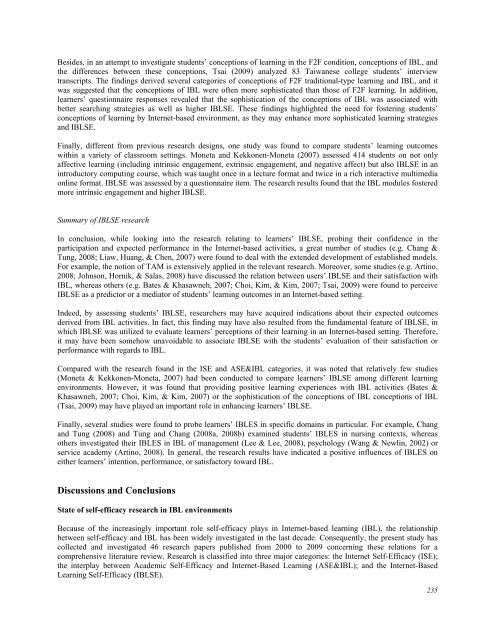October 2011 Volume 14 Number 4 - Educational Technology ...
October 2011 Volume 14 Number 4 - Educational Technology ...
October 2011 Volume 14 Number 4 - Educational Technology ...
You also want an ePaper? Increase the reach of your titles
YUMPU automatically turns print PDFs into web optimized ePapers that Google loves.
Besides, in an attempt to investigate students’ conceptions of learning in the F2F condition, conceptions of IBL, and<br />
the differences between these conceptions, Tsai (2009) analyzed 83 Taiwanese college students’ interview<br />
transcripts. The findings derived several categories of conceptions of F2F traditional-type learning and IBL, and it<br />
was suggested that the conceptions of IBL were often more sophisticated than those of F2F learning. In addition,<br />
learners’ questionnaire responses revealed that the sophistication of the conceptions of IBL was associated with<br />
better searching strategies as well as higher IBLSE. These findings highlighted the need for fostering students’<br />
conceptions of learning by Internet-based environment, as they may enhance more sophisticated learning strategies<br />
and IBLSE.<br />
Finally, different from previous research designs, one study was found to compare students’ learning outcomes<br />
within a variety of classroom settings. Moneta and Kekkonen-Moneta (2007) assessed 4<strong>14</strong> students on not only<br />
affective learning (including intrinsic engagement, extrinsic engagement, and negative affect) but also IBLSE in an<br />
introductory computing course, which was taught once in a lecture format and twice in a rich interactive multimedia<br />
online format. IBLSE was assessed by a questionnaire item. The research results found that the IBL modules fostered<br />
more intrinsic engagement and higher IBLSE.<br />
Summary of IBLSE research<br />
In conclusion, while looking into the research relating to learners’ IBLSE, probing their confidence in the<br />
participation and expected performance in the Internet-based activities, a great number of studies (e.g. Chang &<br />
Tung, 2008; Liaw, Huang, & Chen, 2007) were found to deal with the extended development of established models.<br />
For example, the notion of TAM is extensively applied in the relevant research. Moreover, some studies (e.g. Artino,<br />
2008; Johnson, Hornik, & Salas, 2008) have discussed the relation between users’ IBLSE and their satisfaction with<br />
IBL, whereas others (e.g. Bates & Khasawneh, 2007; Choi, Kim, & Kim, 2007; Tsai, 2009) were found to perceive<br />
IBLSE as a predictor or a mediator of students’ learning outcomes in an Internet-based setting.<br />
Indeed, by assessing students’ IBLSE, researchers may have acquired indications about their expected outcomes<br />
derived from IBL activities. In fact, this finding may have also resulted from the fundamental feature of IBLSE, in<br />
which IBLSE was utilized to evaluate learners’ perceptions of their learning in an Internet-based setting. Therefore,<br />
it may have been somehow unavoidable to associate IBLSE with the students’ evaluation of their satisfaction or<br />
performance with regards to IBL.<br />
Compared with the research found in the ISE and ASE&IBL categories, it was noted that relatively few studies<br />
(Moneta & Kekkonen-Moneta, 2007) had been conducted to compare learners’ IBLSE among different learning<br />
environments. However, it was found that providing positive learning experiences with IBL activities (Bates &<br />
Khasawneh, 2007; Choi, Kim, & Kim, 2007) or the sophistication of the conceptions of IBL conceptions of IBL<br />
(Tsai, 2009) may have played an important role in enhancing learners’ IBLSE.<br />
Finally, several studies were found to probe learners’ IBLES in specific domains in particular. For example, Chang<br />
and Tung (2008) and Tung and Chang (2008a, 2008b) examined students’ IBLES in nursing contexts, whereas<br />
others investigated their IBLES in IBL of management (Lee & Lee, 2008), psychology (Wang & Newlin, 2002) or<br />
service academy (Artino, 2008). In general, the research results have indicated a positive influences of IBLES on<br />
either learners’ intention, performance, or satisfactory toward IBL.<br />
Discussions and Conclusions<br />
State of self-efficacy research in IBL environments<br />
Because of the increasingly important role self-efficacy plays in Internet-based learning (IBL), the relationship<br />
between self-efficacy and IBL has been widely investigated in the last decade. Consequently, the present study has<br />
collected and investigated 46 research papers published from 2000 to 2009 concerning these relations for a<br />
comprehensive literature review. Research is classified into three major categories: the Internet Self-Efficacy (ISE);<br />
the interplay between Academic Self-Efficacy and Internet-Based Learning (ASE&IBL); and the Internet-Based<br />
Learning Self-Efficacy (IBLSE).<br />
235

















